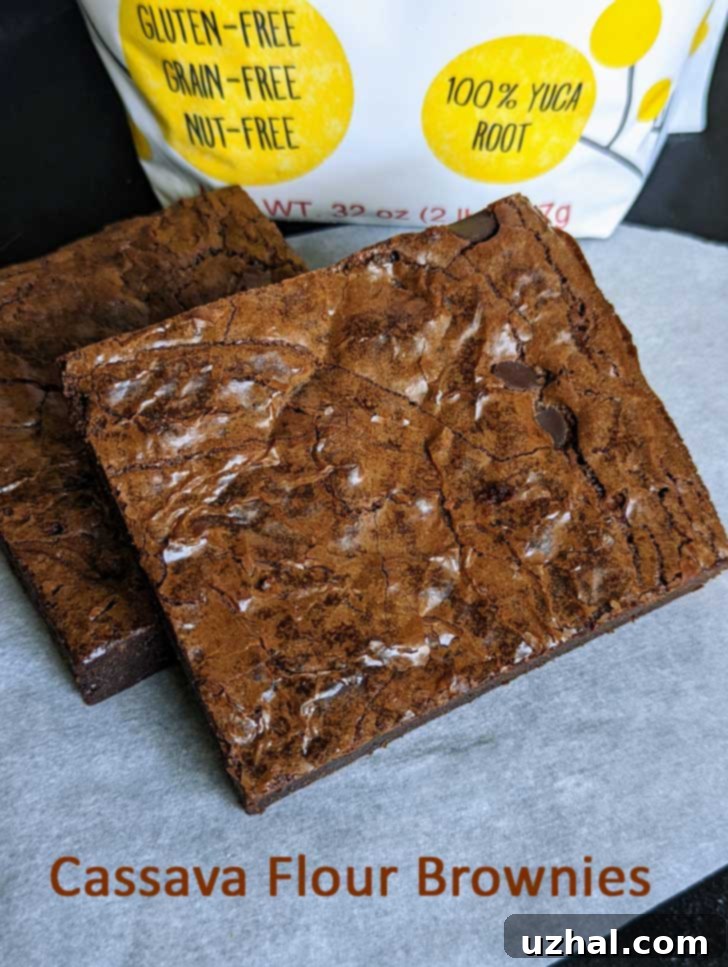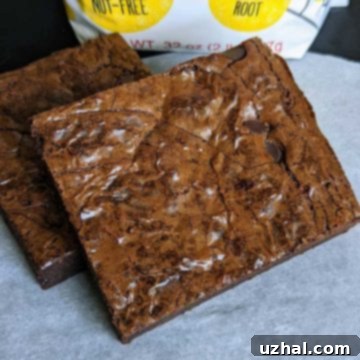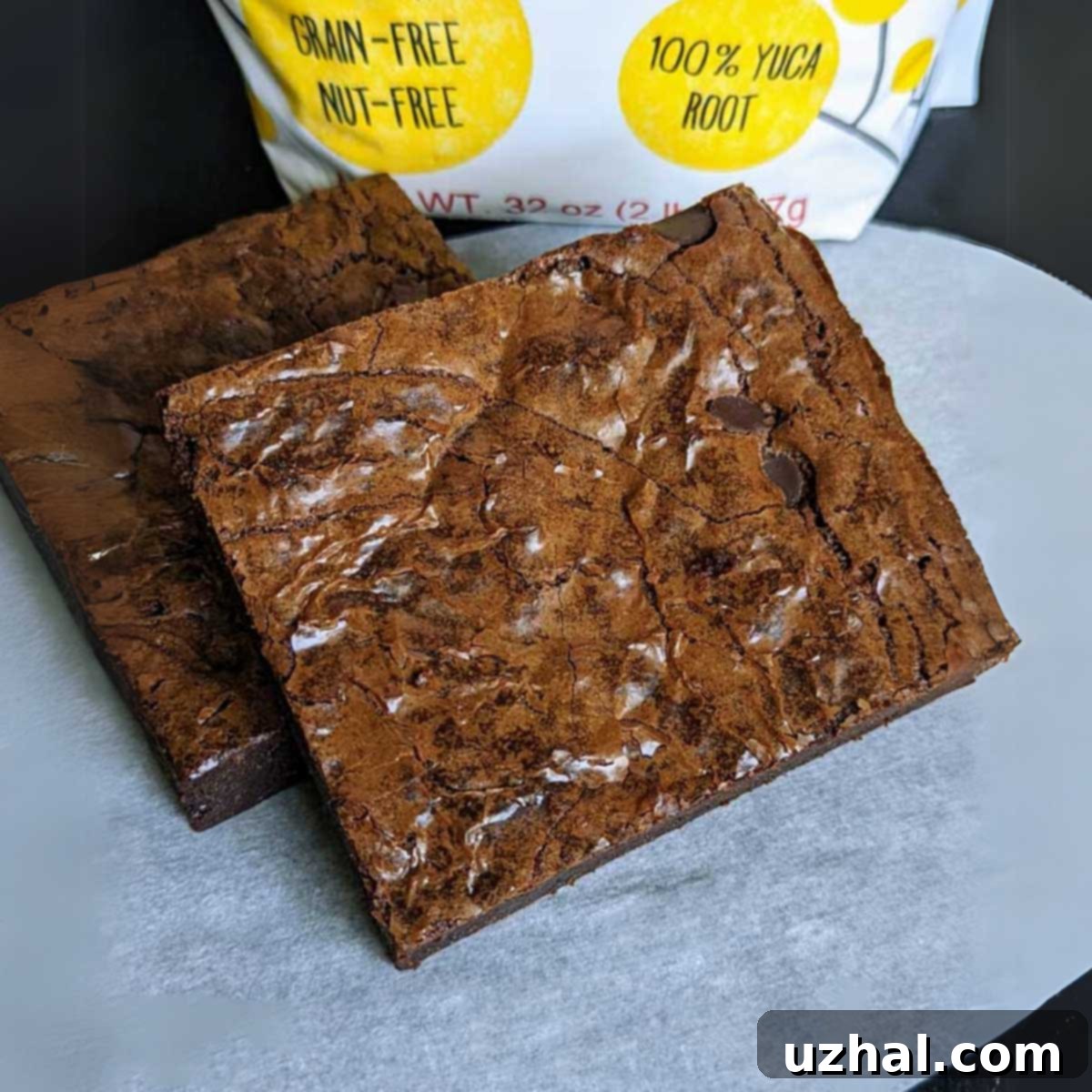The Ultimate Guide to Fudgy Grain-Free Cassava Flour Brownies
After a delightful experience making Tapioca Flour Brownies a few months ago, which honestly rivaled many traditional wheat-based versions, I was eager to explore other grain-free alternatives. Given the close relationship between cassava and tapioca flour, it felt natural to next try my hand at Cassava Flour Brownies. This journey was not just about finding a gluten-free substitute, but about discovering a new favorite brownie recipe that delivers on texture, flavor, and overall satisfaction. Join me as we dive into the world of cassava flour and how it transforms these brownies into an unbelievably fudgy and delicious treat.

Cassava Flour vs. Tapioca Flour: Understanding the Differences for Baking
While often grouped together due to their shared origin, cassava flour and tapioca flour have distinct characteristics that are crucial for successful baking. Both come from the starchy root of the cassava plant, also known as yuca, a staple food in many tropical regions. However, their processing and resulting properties are quite different.
- Cassava Flour: This is essentially a whole food flour, made by peeling, drying, and grinding the entire cassava root. Because it includes the whole root, it retains more fiber and has a slightly more complex flavor profile. In terms of texture and function, cassava flour behaves remarkably similarly to wheat flour in many recipes, making it an excellent 1:1 substitute in a wide variety of baked goods. Its ability to absorb moisture and provide structure without the need for additional gums or binders is a significant advantage for gluten-free bakers.
- Tapioca Flour (or Tapioca Starch): In contrast, tapioca flour is the extracted starch from the cassava root. The root is grated and washed to separate the starch, which is then dried into a fine, white powder. This process removes the fiber, resulting in a product that is pure starch. Tapioca flour is primarily known for its thickening properties and its ability to add chewiness and crispness to baked goods. It’s a common component in gluten-free flour blends, where it works in conjunction with other flours to achieve the desired texture, rather than being a standalone substitute for wheat flour.
The key takeaway for bakers is this: while tapioca flour is fantastic for specific textural enhancements and thickening, cassava flour offers a more robust, wheat-flour-like structure, making it a versatile base for recipes like these fudgy brownies. My previous Tapioca Flour Brownies were an exception, demonstrating that with the right ratios, tapioca can shine, but generally, cassava flour provides a more straightforward path to gluten-free baking success.
Coconut Sugar vs. Granulated Sugar: Sweetener Choices for Your Brownies
For this particular brownie recipe, I opted for coconut sugar instead of traditional brown sugar, and this choice brings several nuances to consider. Coconut sugar, derived from the sap of the coconut palm, has gained popularity as a natural sweetener. It boasts a beautiful caramel-like flavor, which subtly enhances the depth of chocolate in these brownies. However, understanding its physical properties is key to successful substitution.
- Weight and Moisture: One significant difference lies in its weight and moisture content. Traditional granulated sugar and brown sugar typically weigh around 200 grams per cup. My experience with Trader Joe’s brand coconut sugar, which tends to be on the drier side, showed it weighed approximately 140 grams per cup. This lower density means a cup of coconut sugar contains less actual sugar by weight compared to a cup of granulated sugar.
- Substitution Guidance: If you decide to substitute granulated sugar for coconut sugar in this recipe, you might want to adjust the quantity. Using a 1:1 volume swap could result in a sweeter brownie due to the higher sugar density of granulated sugar. A good starting point would be to use less granulated sugar – perhaps ¾ cup (or approximately 140-150 grams) to match the sweetness level and maintain the delicate balance of the brownie. I plan to test this substitution and will provide updates. Alternatively, a blend of brown and granulated sugar, totaling around 140 grams, could also yield excellent results, offering a balance of flavor and moisture.
- Flavor Profile: Beyond the technical aspects, coconut sugar imparts a distinct, mild caramel note that complements the chocolate beautifully. While granulated sugar provides a more neutral sweetness, allowing the chocolate to be the dominant flavor, coconut sugar adds an extra layer of complexity. Experimentation with different sweeteners can be a fun way to customize your brownies to your personal preference.
Achieving Perfect Fudgy Texture and Rich Flavor with Cassava Flour
Now, let’s get back to the star of the show: these incredible cassava flour brownies. My tangential exploration into coconut sugar was warranted, but the true magic happens when all the ingredients come together to create a truly exceptional dessert. The texture of these brownies was precisely what I look for: intensely fudgy, dense, and moist, without any of the undesirable grittiness that can sometimes plague gluten-free baked goods. This smooth, melt-in-your-mouth quality is a testament to the effectiveness of cassava flour.
Many gluten-free flours, especially coarser ones or those with high starch content that isn’t balanced, can lead to a dry, crumbly, or grainy texture. Cassava flour, however, manages to mimic the elasticity and binding power of wheat flour, contributing to a wonderfully cohesive and moist crumb. It creates a brownie that feels substantial and satisfying, delivering that classic rich brownie experience without the gluten.
The flavor profile was equally impressive. Sweet, as expected, but beautifully balanced by the deep notes of chocolate and the subtle, slightly caramel undertones from the coconut sugar. It wasn’t overly sweet, allowing the quality of the chocolate to shine through, complemented by that hint of tropical sweetness. I’m excited to try these again with other sweeteners to compare the flavor nuances, but as a first attempt using cassava flour and coconut sugar, these brownies were an absolute triumph. They are a genuinely delicious and effective way to utilize cassava flour in your baking repertoire, proving that gluten-free doesn’t mean compromising on taste or texture.
Why Choose Cassava Flour for Your Baking?
Beyond these amazing brownies, cassava flour offers numerous benefits that make it a standout ingredient for gluten-free and grain-free baking. It’s not just a good substitute; it’s a fantastic flour in its own right.
- Allergen-Friendly: Cassava flour is naturally gluten-free, grain-free, and nut-free, making it an excellent choice for individuals with various dietary restrictions or allergies. It opens up a world of baking possibilities for those who can’t consume traditional wheat flour or common gluten-free blends that might contain other allergens.
- Neutral Flavor Profile: While it comes from a root vegetable, processed cassava flour has a surprisingly neutral taste. This allows the other flavors in your recipe, like chocolate or fruit, to truly shine without any overpowering earthy notes. This neutrality is a huge advantage compared to some other alternative flours that can impart distinct, sometimes unwanted, flavors.
- Excellent Texture: As demonstrated by these brownies, cassava flour helps achieve fantastic textures. It binds well, provides structure, and contributes to a moist and tender crumb in baked goods. It helps prevent the dryness and grittiness often associated with gluten-free baking, leading to results that are often indistinguishable from their wheat-based counterparts.
- Versatility: Its 1:1 substitution ratio for wheat flour in many recipes makes it incredibly versatile. From breads and cakes to cookies and, of course, brownies, cassava flour can be used in a wide range of applications, simplifying the process of converting traditional recipes to gluten-free versions.
Embracing cassava flour in your kitchen can transform your gluten-free baking, delivering delicious, high-quality results every time. These brownies are just the beginning!
- Cassava Flour Banana Bread
- Otto’s Cassava Flour Biscotti
- Tapioca Flour Brownies
- Small Batch Gluten Free Brownies
- Small Batch Gluten Free Brownies
Recipe

Cassava Flour Brownies
Cookie Madness
Pin Recipe
Ingredients
- 5 tablespoons unsalted butter, cut into chunks (70 grams)
- 1 cup semisweet chocolate chips (170 grams)
- 2 tablespoons unsweetened cocoa powder, natural (10-12 grams)
- 1 cup coconut sugar (see note about substituting granulated)
- 2 large eggs
- 1 teaspoon vanilla extract
- ¼ teaspoon salt
- ¼ cup cassava flour or a gluten-free blend without xanthan gum or all-purpose flour
- ⅓ cup more chocolate chips or chocolate pieces
Instructions
-
Preheat oven to 350 degrees F. Line an 8 inch square metal pan with foil and grease the bottom only.
-
Melt the butter in a large saucepan set over medium heat. Reduce heat to low, add chocolate chips and stir until melted, then stir in the cocoa powder. Stir until smooth, then stir in ½ cup of the sugar. Stir just until mixture is shiny, then remove from heat. Let cool for 3 minutes.
-
Whisk in the cold eggs, one at a time, then whisk in the remaining sugar, vanilla and salt.
-
Stir in the cassava flour just until combined. Transfer mixture (it will be very thick) to the pan and spread evenly. Bake in a 350 degree oven for 30 to 35 minutes (but check at 25).
-
Allow the brownies to cool completely, then lift from the pan and cut into squares.
Notes
Final Thoughts on These Grain-Free Delights
Embarking on the journey to create these Cassava Flour Brownies was a truly rewarding experience. From comparing the unique characteristics of cassava and tapioca flours to understanding the impact of sweeteners like coconut sugar, every step contributed to a deeper appreciation for the art and science of gluten-free baking. The resulting brownies were not just a successful experiment; they were a testament to how innovative ingredient choices can lead to baked goods that are every bit as delicious and satisfying as their traditional counterparts.
The rich, intense chocolate flavor, combined with the perfectly fudgy texture and the subtle caramel notes from the coconut sugar, makes these brownies a must-try for anyone seeking a delightful grain-free dessert. Whether you’re navigating dietary restrictions or simply looking to expand your baking horizons, this recipe offers a fantastic opportunity to explore the versatility of cassava flour. Don’t hesitate to give them a try, and perhaps even experiment with your own twists on sweeteners and mix-ins. Happy baking!
